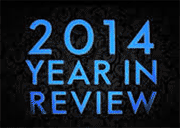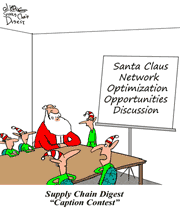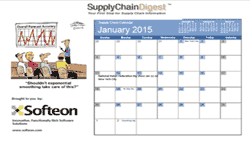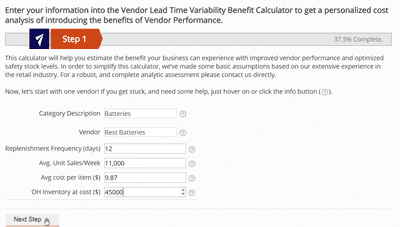The Year in Supply Chain 2014
It was again a very interesting year in supply chain for 2014 - but aren't they all these days?
This week, I will summarize what I feel are the most important key themes and trends of the supply chain year that was. Next week in our OnTarget newsletter, we'll publish our popular timeline of key events over the past year. In two weeks (after a pause for a summary of next week's National Retail Federation conference) I will be back for a review of the year in numbers and graphs.
So let's get right to it, starting with the really big picture.
| GILMORE SAYS: |
"After appearing a bit like the boy who cried Wolfe in previous years, 2014 is the year the driver shortage really started to hit home."
WHAT DO YOU SAY?
Send us your
Feedback here
|
The economy underlying our supply chains started weak in the US and ended strong, with Q1 real GDP falling 2.1% - largely blamed on bad weather - and ending with signs of strength, with the latest estimate for Q3 GDP growth of a robust 5%.
It does feel better economically right now than for a long time, as we learned to live with the "new normal" of positive but weak growth of 2% or so.
But the US economy is somewhat under threat from a global environment that continues to sputter. Growth in Europe has been weak or even negative, with a real and justified fear of deflation. Despite massive stimulus, Japan's economy has again stalled, and it is responding with even more massive stimulus. China's growth has slowed to about 7%, still hefty by most standards, but trending down and putting a drag on other countries and most notably commodity and input prices, good for many but not all and perhaps a sign of weakness.
The first half of the year was also overshadowed by geopolitical events that seemed possible to ignite into real conflict, but luckily mostly did not. That included Russia's invasion of Crimea and Ukraine, tensions in the South China Sea between an aggressive China and many of its neighbors over control of ocean and land, the seeming likelihood Israel would attack Iran's nuclear facilities and more.
But by year's end most of those tensions had died down but certainly not out, with some renewed risks for 2015, as I will discuss below.
With that high-level overview, here are what I view as the four key trends or themes relative to supply chain in 2014:
The Collapse of Oil Prices and the Rise of US Fracking: It is almost hard to believe what is now occurring, with US oil prices falling to below $50 per barrel and global prices just a few bucks above that, down around 50% since the middle of the year. Not much talk of Peak Oil now, is there? Who would have ever guessed, in the absence of a deep recession.
There are many causes, from a strong dollar to weak global demand, but key is surging US production that has taken it to the top of the oil producer list due to the magic of fracking. That has added millions of barrels per day to the global supply. Indeed, Saudi Arabia is said to have decided not to reduce production to drive prices back up because it actually hoped they would fall below where it was economical for US frackers to keep production going.
This astounding turn has more ramifications than we can list here, but let's start with some key ones. The financial pressure the oil price fall is putting on countries such as Russia, Iran, Venezuela and others is good to see, at one level, but could cause them to lash out in some form to take their citizens' minds off all the bad economic news. This is a real danger the longer this lasts.
 The big drop in oil and most other commodities increases the still very present possibility of devastating deflation in Europe, Japan and elsewhere, a concern even in the US. The big drop in oil and most other commodities increases the still very present possibility of devastating deflation in Europe, Japan and elsewhere, a concern even in the US.
Many commenters have noted that the falling energy prices are a real threat to many Green supply chain and clean energy programs, as the economic landscape has been turned on its head. It was easy to reduce CO2 emissions when the ROI was also strong, but the numbers will often be very different now.
Will it last? Who knows. But if these low prices persist, just as we spoke about the need to rethink supply chain network designs considering that oil would stay at $100 per barrel or more for the long run, should not that same thinking apply on the way down too? Maybe the companies that did little to change their networks in the face of rising oil prices will have the last laugh on this one for a few years.
Continued OmniChannel Madness: OmniChannel developments continued to come fast and furious, so much so that it was hard to keep track of them, even for us here at SCDigest that do it for a living.
Amazon by itself had a series of tests and innovations, including piloting same day deliveries with commercial taxies in San Francisco and rolling out a new immediate delivery service (Amazon Prime Now) in Manhattan using bike couriers. It launched a new line of private label goods that could be a threat to branded consumer package goods companies, announced plans to aggressively expand its grocery business to new markets and much more. "Amazon shows us what is possible," a Walmart exec said.
"Click and collect" emerged as something of a "killer app" for ecommerce, in which customers place orders online and the goods are either delivered to lockers or to a drive through type location at a retail store where merchandise is loaded by a store employee into the consumer's trunk. Walmart is betting big on this strategy, hoping this and same day deliveries using its vast store network will give it an advantage Amazon can't match.
DHL is testing drone deliveries in Europe, Macy's is counting on RFID to empower inventory accuracy for store-based efulfillment, UBER is setting up efulfillment capabilities, etc.
And don't be confused that all this omnichannel madness applies only to retailers.
Acute US Driver Shortage: After appearing a bit like the boy who cried Wolfe in previous years, 2014 is the year the driver shortage really started to hit home. There was a new sense of urgency among trucking companies describing the situation, and nearly all - some substantially - raised driver pay during the year.
But it wasn't nearly enough, as an expanding economy drove freight volumes to record levels, while capacity was capped first by carrier strategy, then by a lack of drivers. So, we saw substantial increases in rates for the last nine months of the year.
According to Cass Information Systems, year over year increases in truckload rates in March through November, respectively, were 6.0%, 5.7%, 5.8%, 5.2%, 7.2%, 7.0%, 6.7%, 7.3%, and 6.5%. This cost nightmare for shippers is being partially offset by falling oil prices, but diesel costs were down only 17% in 2014, much less than gasoline, for a variety of reasons.
If the economy does show strong growth in 2015, watch out.
US Port Chaos: Service at US ports was lousy for much of the year, in some East Coast ports more in the first half of the year, West Coast ports in the second half.
A common theme: chassis mismanagement, of all things. As the carriers exited the low-margin business in recent years and sold it off to third parties on both coasts, chaos generally ensued. It usually was not so much a matter of the total number of chassis at a port, but rather where they were located.
This should be an easy problem to solve, and appears to have ameliorated on the East Coast, with a new program coming at LA/Long Beach soon.
On the West Coast, the chassis issue plus increased volumes plus what sure look like work slowdowns by the ILWU over the lack of a new contract have led to huge congestion and long delays basically since October, causing something of a nightmare for importers.
Those are my key 2014 supply chain themes. We'll have our full 2014 timeline next week in OnTarget, but the top events for me include: workers at a VW plant in Chattanooga vote against unionization in major blow to UAW; Zebra Technologies surprisingly announces it will acquire the radio frequency systems and bar code scanning business from Motorola Solutions; China blocks formation of the P3 network of ocean carriers; US manufacturing finally exceeds 2007 levels in July; UPS and FedEx implement full dimensional weighing programs at year's end; and the NLRB approves "microwave" elections and other changes in December in the biggest change to labor law in decades in a pro-union move.
What's your take on 2014?
Any comments on our review of 2014 in supply chain? What did you see as key themes or events? Let us know your thoughts at the Feedback button (email) or section (web form) below.
|










 The big drop in oil and most other commodities increases the still very present possibility of devastating deflation in Europe, Japan and elsewhere, a concern even in the US.
The big drop in oil and most other commodities increases the still very present possibility of devastating deflation in Europe, Japan and elsewhere, a concern even in the US.

